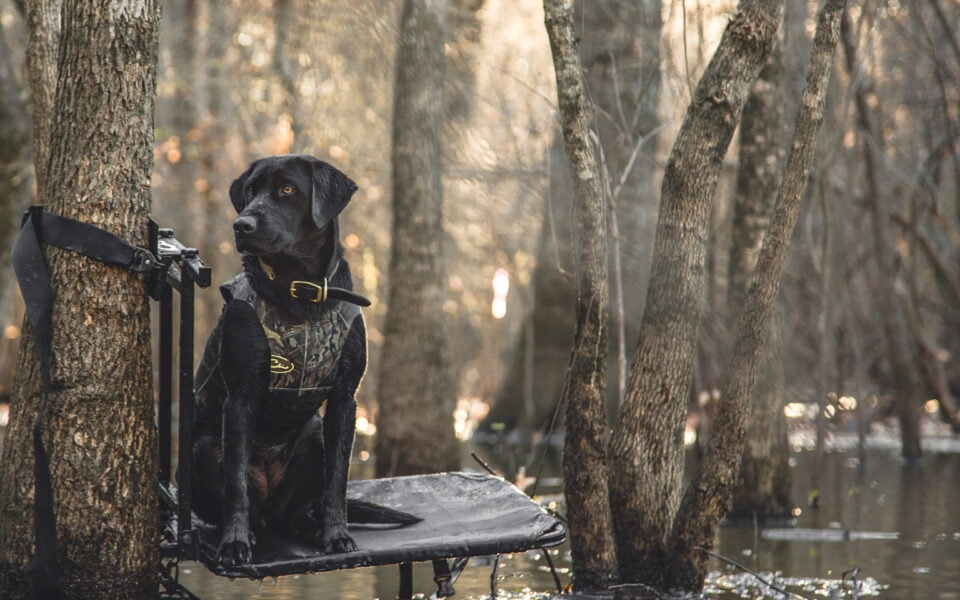There are many dangers that dogs may encounter on a hunt such as: bites by both venomous and non-venomous snakes; hyperthermia and hypothermia; water obstructions-especially beaver stobs; encounters with barbed wire and other type fences; ice on ponds and streams; and retrieving live birds-especially crows, swans and cranes. Here are some things you can do to prevent issues and how to deal with them if they do occur.
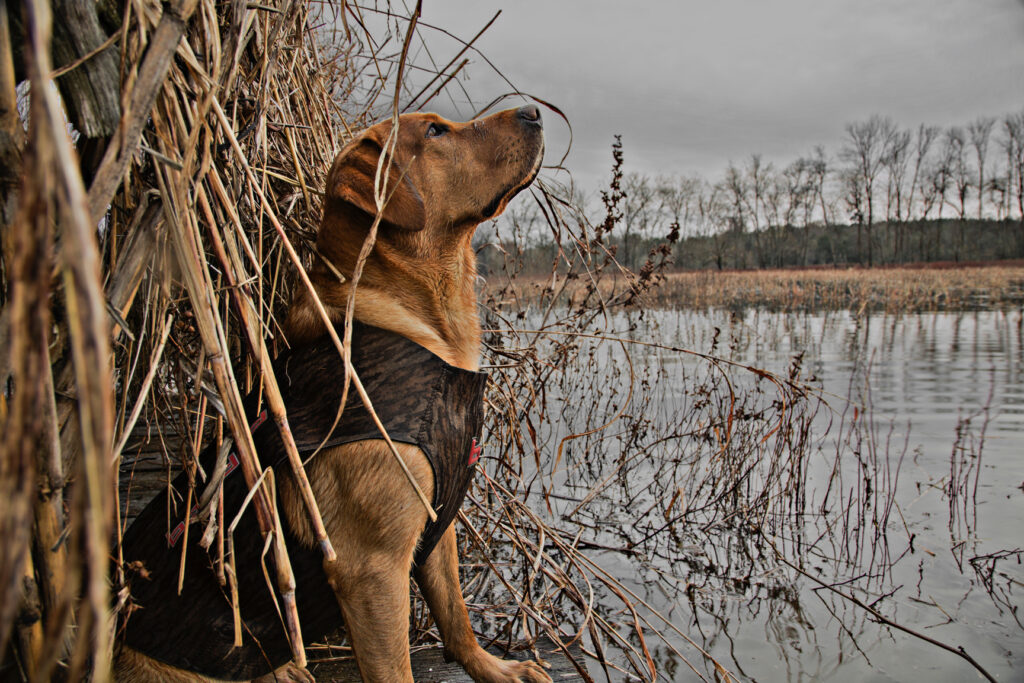
Snake Bites
Depending on the part of the country you live in, the most likely venomous snake encounters will be rattlesnakes, copperheads, or cottonmouths. In my years of training, I have had three dogs that have been bitten by venomous snakes. Our veterinarian identified one as a rattlesnake bite and the other two as copperhead bites. The rattlesnake bite happened in the side yard at my residence. One copperhead bite occurred inside a kennel here at Mossy Oak, and the other in a duck hole while hunting in the dead of winter. The point being that snake bites can occur anyplace and at any time.
Dogs are very good at finding snakes and if you see your dog barking at the ground, it is probably barking at a snake. If your dog yelps and jumps back, it has probably been struck at or bit by the snake. If a venomous snake has struck your dog, the bite site will quickly swell and upon close inspection of the bite area, you will see fang marks. When a strike occurs, you should immediately get your dog away from the area to prevent another strike. Don’t waste a lot of time looking for the snake, if you can identify it quickly, do so, but it is more important to treat your dog in the field and get it to a veterinarian as quickly as possible. If no fang marks are present the snake is probably non-venomous, but if it broke the skin the dog still runs a risk of infection and needs to see a veterinarian to get a few rounds of antibiotics to prevent infection.
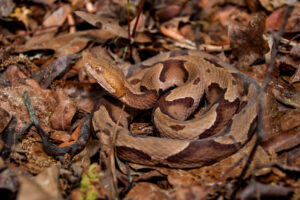
Other symptoms of a venomous bite, other than fang marks, include swelling, severe pain, panting and/or drooling. In addition, depending on the quantity of venom injected, your dog may become lethargic to the point of collapse, experience seizures or have respiratory problems. The best option is to carry your dog to your vehicle or, if unable to carry, slowly walk your dog to your vehicle. By carrying or walking the dog slowly, you will slow the spread of venom through the dog’s body. Most importantly, get your dog to the nearest vet as soon as possible!
Every time you go in the field, you should carry an emergency dog first aid kit. To deal with snakebites, the kit should include a bottle of Children’s Liquid Benadryl, and a teaspoon and/or a syringe to administer the correct dosage. When you determine that your dog has been struck by a venomous snake, it is generally recommended that you give the dog 1 teaspoon of Benadryl for every 12.5 pounds of body weight or, if using a syringe, 5ml of Benadryl for every 12.5 pounds of body weight. To conserve time, it is better to administer the Benadryl while in route to the local veterinarian clinic, but only if you have someone with you. Otherwise, give the dosage before you travel.
“IT’S ABOUT CREATING A LEGACY FOR ALL FUTURE GENERATIONS. SUBSCRIBE TODAY!”
Hyperthermia In Dogs
“Hyperthermia” by definition is having a temperature above normal. Normal in a lab is 100.5 to 102.5 degrees Fahrenheit. So, how do you know that your retriever is overheating? The primary source of heat exchange for a dog is panting, so if a dog is panting, they are beginning to overheat. But, there are other indicators such as: dehydration, excessive drooling, curled tongue, red gums etc. When training or hunting, I rely on an easy and surefire method for early detection of heat exhaustion and that is to keep a close watch on the tip of his tongue. When the tip starts to turn red and starts to curl, it is time to give the dog a long break and possibly quit for the day. Otherwise, you run the risk of allowing your dog to suffer the dire consequences of a heat stroke.
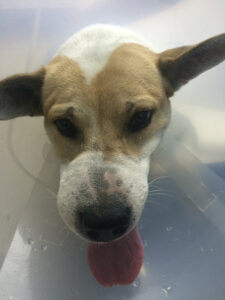 Dr. Karen Emerson, DVM states that hyperthermia can be caused by lack of conditioning, lack of acclimazation and very high humidity and temperatures. She further noted that hunting dogs are very energetic and love the thrill of the hunt. They love to please their owners and get the gratification. It is the responsibility of the owner/trainer to make sure the dog is monitored and rested appropriately and hydrated. Only small amounts of water should be given throughout the hunt. Do not allow the dog to drink excessively as this can lead to nausea and bloated stomach. The clinical sign of hyperthermia is panting to extreme hyperventilation and hyper-salivation, and altered mentation (a glassy-eyed look). They then experience a drunken like stupor, some have vomiting and diarrhea.
Dr. Karen Emerson, DVM states that hyperthermia can be caused by lack of conditioning, lack of acclimazation and very high humidity and temperatures. She further noted that hunting dogs are very energetic and love the thrill of the hunt. They love to please their owners and get the gratification. It is the responsibility of the owner/trainer to make sure the dog is monitored and rested appropriately and hydrated. Only small amounts of water should be given throughout the hunt. Do not allow the dog to drink excessively as this can lead to nausea and bloated stomach. The clinical sign of hyperthermia is panting to extreme hyperventilation and hyper-salivation, and altered mentation (a glassy-eyed look). They then experience a drunken like stupor, some have vomiting and diarrhea.
It is so important if these clinical signs are noted to slow the dog down, get the dog to a shaded area and start to cool them down with cool water spray and/or rub ice on their belly-this will help decrease their temperature. You can also place the dog in an air-conditioned vehicle to allow cool down. When the body has an extremely high temperature the internal tissue can be cooked causing the body to go into shock and then can lead to death. It is very important to acclimate the dog to the environment for about 20 minutes – this is the same as an athlete warming up prior to a big game. Also, toward the end of the hunt, allow the dog to cool down with low activity for about 10 minutes; this allows the animal to cool down and not just abruptly stop working.
Many hunters mistakenly believe that if their dog begins to overheat the best solution is to let them swim in a pond or lake to cool-off. While this tactic is better than nothing, you aren’t going to gain much in terms of relief from elevated body temperature because the surface temperature of the water.
Many believe that on extremely hot days it is safer to work a retriever in the water. The temperature of the water is about the same as the ambient temperature of the air, or higher, and just as on land, the dog can easily overheat while retrieving in water. So what can you do?
From a prevention standpoint, don’t put your dog in a training situation or a hunting situation that would expose them to a possible heat stroke by limiting the number of retrieves, keeping them in the shade out of direct sunlight, and keeping them well hydrated with a good supply of cool water for him to drink. Especially on dove hunts, always take a supply of cool water and a bowl for your dog. To keep your dog hydrated, give it an ample supply of water and then let them rest for a few minutes. Then resume retrieving and after a few more retrieves, let them drink again. To avoid water intoxication, don’t keep water in the bowl at all times; instead, ration it out so that the dog’s intake is no more than its body can process.
Always be observant by keeping a watchful eye on your retriever looking for any signs of overheating and upon seeing the first sign, the tip of the tongue turning red and beginning to curl, STOP immediately, allow them to rest.
“IF YOU LOVE WILDLIFE AND WANT TO IMPROVE HABITAT SUBSCRIBE TODAY!”
Hypothermia In Dogs
At the opposite end of the spectrum, is hypothermia. Again, a dog’s normal body temperature is 100.5 to 102.5 degrees Fahrenheit. By definition, hypothermia is low body temperature caused by exposure to extreme cold for an extended period. The three levels of hypothermia are mild, moderate, and severe. The symptoms vary with the level of hypothermia. Low-level symptoms include weakness, shivering, and becoming lethargic. More advanced symptoms include muscle stiffness, lack of mental acuity, and shallow breathing. While there are many reasons for the onset of hypothermia, the principal reasons are the owner simply doesn’t know the causes and symptoms or the preventative measures that can be followed to greatly reduce the risk of the onset of hypothermia.
In hot weather, dogs lose body temperature by panting and to a lesser extent by sweating thru their paws, thereby cooling themselves down when their body temperature climbs. So it stands to reason that the reverse is also true, when a dog is standing in cold water they are losing body heat thru their paws. Couple this loss with the loss of body heat when swimming out to the blind and then back to the bank and exposure to the cold water on multiple retrieves during the hunt – the totality of heat loss can reach severe limits in short order. When this begins to happen, continued exposure to the cold can easily lead to the dog going into a downward spiral, that is, its muscles demand for energy increases and the elevated use of blood glucose to fuel its muscles quickly causes glucose levels to plummet to a critical level. As the dogs’ glucose levels are drawn down to increase body heat, the dog continues to lose body heat from the cold, the glucose levels continue to drop and the dog begins to exhibit the signs of hypothermia or hunting dog hypoglycemia – a potentially fatal condition.
Dr. Emerson added that hypoglycemia, or low blood sugar, normally occurs during the hyperthermia and hypothermic situation. A dog’s normal blood glucose is 70-150mg/dl. During hypoglycemia, the blood sugar can drop to 50 or below. The clinical signs of hypoglycemia are altered mentation acting drunk, trembling excessively and showing extreme weakness and can collapse and show seizure activity. It is very important to allow your dog to eat a small meal before the hunt to avoid this state. Most times this occurs in younger hunting dogs that are extremely anxious and exerting a lot of energy. The small meal should consist of a high protein diet. The owner should keep Karo Syrup, honey or fruit juices incase the dog experiences this episode. You just rub the honey or karo syrup on the gums to bring the blood sugar back to normal. If the dog is collapsing, a veterinarian needs to be seen, but put the karo syrup and/or honey on the gums on the way to the hospital.
Working dogs, like Labrador retrievers, burn a lot of fuel in an average day of duck hunting. In fact, I have been told that a working Labrador consumes 80% more fuel (glucose) while hunting than it will during an average day at the kennel. Assuming this percentage is factual, it makes sense that a working Lab’s food intake needs to be increased exponentially to provide the necessary fuel for a hard day of hunting-especially in cold weather.
At the kennel, with the onset of cold weather, we always increase the amount of food given to our labs and we feed our labs once a day – always in the evening. Because by feeding in the evening our dogs have overnight to digest the food and gain the maximum nutritional value from the food – allowing them to build levels of glucose sufficient to power their muscles for the duration of a hunt in cold weather.
“BECOMING A GAMEKEEPER IS NOT JUST THE BEST WAY TO PRODUCE GREAT HUNTING… IT’S THE BEST LIFE! SUBSCRIBE TODAY.”
The loss of body heat can also be slowed by:
1) Putting a neoprene vest on your dog during the hunt to retain body heat.
2) Never taking your dog duck hunting in a place where he/she cannot get completely out of the water.
3) Never placing your dog at risk by allowing the dog to wade or swim a long distance to or from your blind and making too many retrieves over the course of the hunt.
4) Never allowing your dog to sit or stand in cold water for an extended period.
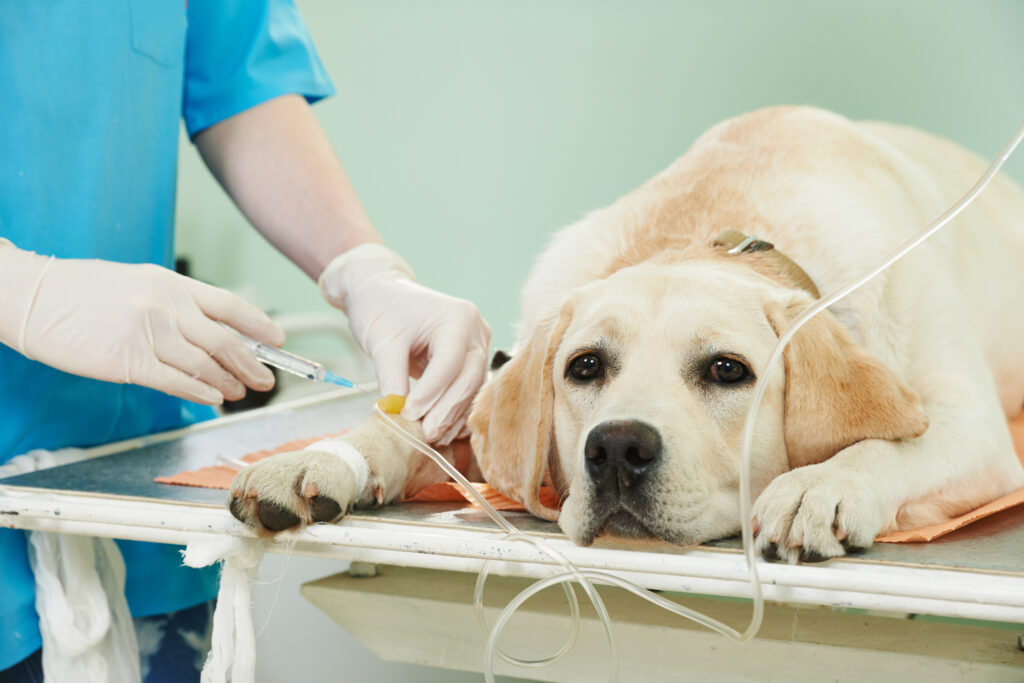
One last point, leaving your dog sitting in or standing in cold water (even an inch or two) not only escalates the onset of hypothermia but, it also exposes your dog to possible frostbite of the feet and toes, the tips of the ears, the end of the tail, and the scrotum. The point to remember in all of this is don’t expose your dog to a situation that could bring on the onset of hypothermia or frostbite and when you observe the first sign “shivering”, it is time to take action. Get the dog out of the water and warmed up. In extreme cases, this may mean abandoning the hunt, carrying your dog to the truck and running the heater, but it must be done.
Join our weekly newsletter or subscribe to GameKeepers Magazine.
Your source for information, equipment, know-how, deals and discounts to help you get the most from every hard-earned moment in the field.

